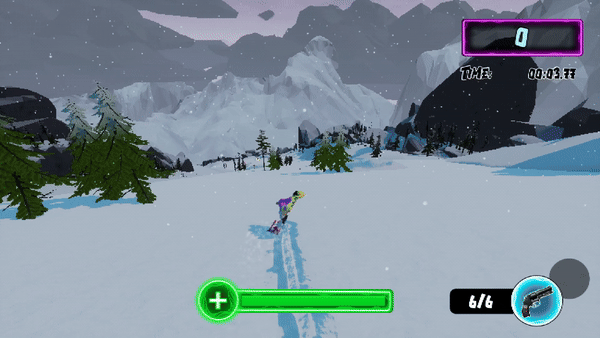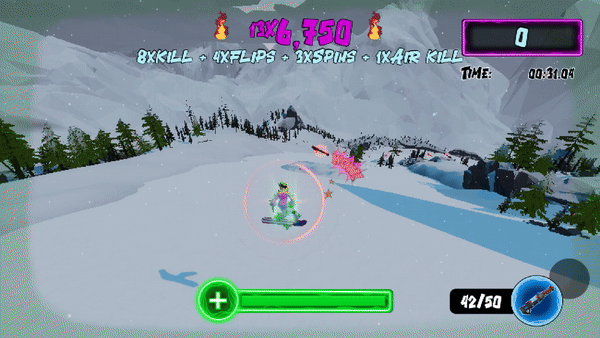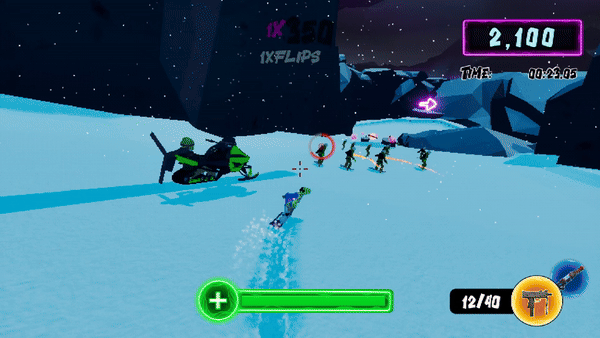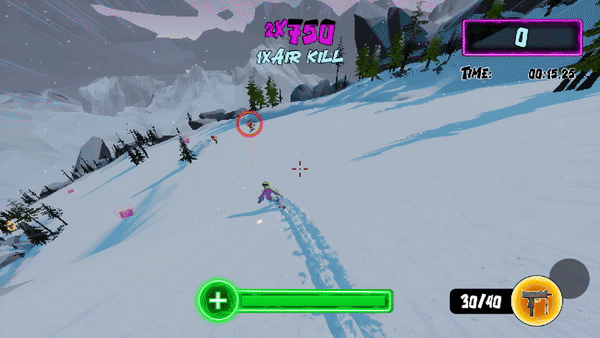
käty
olup


Shred Off is a third-person action-sport shooter game where the player snowboards down Alaskan peaks and guns down enemies while doing awesome tricks, all to get the highest score and dominate the leaderboards. The game is heavily inspired by Rollerdrome and SSX games. Featuring nostalgic PSX-style graphics, it will take many players back to their childhoods.
12 PEOPLE
Level design, art lead
UE5
32 weeks
UNIVERSITY PROJECT

steam release
overview

"Damn, what a fun game! The levels are easy to navigate and super fun to explore. The controls are simple and the weapons feel great, with sound effects that make blasting enemies so satisfying. Overall, it's great stuff. I like it."
- Steam review by OnlyFieryHawkNinja
"I love the high-action mix of snowboarding and shooting bad guys. The old-school arcady visuals really make this feel like those cool ol' arcade games and I love it."
- Steam review by Bardicus
my responsibilities
level design
-
Created the design and white-box block-out for the onboarding level
-
Created the design and white-box block-out for the Subzero Slaughter level
-
Created modular tools for blocking out level
-
Set-dressed onboarding and Subzero Slaughter level
-
Implemented checkpoint systems to the onboarding and Subzero Slaughter levels using tools provided by programmers
-
Created the design for the boost pads
-
In collaboration with a programmer created a tutorial level
art lead
-
Created and updated art documentation for the game
-
Participated in stakeholder meetings
-
Participated in project macro planning
-
Created UI art assets
-
Created set-dressing prefabs
-
Took responsibility for visual cohesion
-
Collaborated with programmers to make sure visuals are implemented in the game
-
Took responsibility for making sure we had the art resources needed
marketing
-
Recorded video clips for the trailers
-
Created the teaser for the game
-
Created and edited the trailer of the game
-
Created the logo of the game
-
Created Steam assets for the game page
-
Created update announcements' visuals
project description
Shred Off is a game where Rollerdrome meets SSX. As a player, you have let loose on an Alaskan mountain. The game offers an exciting mix of doing tricks, picking up weapon pick-ups, and killing enemies which all exist in symbiosis. To rank high in the leaderboards, you as a player must be fast, accurate, and strategic to score the most points.
FAST-PACED ARCADE ACTION
High-octane action with fast-paced gameplay. As a player, you can expect to be kept on your toes in Shred Off. It's an action-packed experience full of explosions, bullets and tricks. Ever dreamed of zapping 5 enemies with your lighting gun when doing a front flip? In Shed Off, this is the new norm.
BACK TO THE 90s
Shred Off features nostalgic PSX-style graphics to hone in on the PS1-era look and feel. Paying tribute to the golden era of action sports games, we went all in on the visuals. Low-poly and pixelized look with vivid neon colors all over the game reinforces the 90s look.
Movement
The player character is constantly moving, the player can control the speed with breaking, however, breaking is a secondary movement mechanic and isn't meant to be used often. The player can control the board by turning left or right, however, the board is programmed to have acceleration only when going downhill which prevents the player from going in circles or uphill. There are three tricks a player can perform: front flip, spin to right, and spin to left. In addition, the player can jump which is especially useful on ramps to get more airtime.

Spin to right and left

Basic movement

Front flip
Combat
The game has four different enemy types: sniper, gunner, Molotov thrower, and snowmobile. Sniper is the only enemy that stands still. Both the gunner and Molotov thrower move on a snowboard. The snowmobile is a vehicle and will charge towards the player when attacking. Both the sniper and snowmobile do the highest damage in the game. All ranged enemy shooting attacks can be deflected which causes the enemy's bullet to backfire and kill the enemy instead. Killing an enemy drops a health orb which replenishes the player's health.

Snowmobile

Sniper

Molotov thrower

Gunner
The game features five different weapons:
Revolver - a six-round semi-automatic weapon, always available for the player if they have no other weapon equipped
Rocket launcher - a two-round semi-automatic explosive weapon, that can be acquired from weapon drops
Submachinegun (SMG) - a 40-round automatic weapon with high accuracy, that can be acquired from weapon drops
Lightning gun - a 50-round automatic weapon that produces lightning that bounces between close-by enemies and damages them, that can be acquired from weapon drops
Minigun - 149-round automatic highest fire rate weapon with low accuracy, that can be acquired from weapon drops

Revolver

Rocket launcher

SMG

Lightning gun

Minigun

project timeline
concepting
level proposal
pre-production
production
release
Playing reference games
Researching the chosen location
Gameplay ideation sketches
Gameplay dynamics investigation
Level layout sketches
Level pillars and one-liners
Player experience (gameplay + narrative)
Amosphere and location
General level flow, key locations and events
Level sketches
Gameplay sketches
Prototype block-out
Level one-pager and documentation
QA, playtesting and iterations
Iterated white-box block-out
Gameplay implementation
UI art assets
Set-dressing
Visual cohesion
Bug fixing
Set-dressing
Marketing
QA and playtesting
Minor iterations






concepting
Gameplay concepts
As a team, we had a relatively long concepting period due to the creative brief being hard to work with. It put us through a lot of prototyping, discussions, and brief changes, however, in the end, we managed to join on-foot combat with vehicle-like movement which we all were very enthusiastic about.

The early state gameplay loops and pillars
Proof of Concept prototype
As a level designer, I took this time to create a prototype for a stronghold to support the concept and to spend more time doing level design experimentations besides focusing on only gameplay. As a quick proof-of-concept level prototype, I created a small map that should seem like an airport since one of the locations from the brief was Eielson Air Force Base near Fairbanks, Alaska.


Airport/air base inspired level prototype
Competitor Analysis
Based on the creative brief, our reference game was Mad Max. However, during concepting, we started to take more inspiration from the Mad Max comics and shifted our game references towards Rollerdrome and SSX. To understand our reference game I analyzed the world/level design and systems design aspects of Mad Max and went more in-depth on the open world design of Mad Max since the creative brief stated that our project should involve an open world, which later was changed due to scoping issues.

Mad Max world and systemes design analysis

Mad Max open world design analysis
Since the project turned into Rollerdrome meets SSX concept, the gameplay and levels were to be inspired by the two games. I found myself fascinated by how in Rollerdrome, gameplay and level design create a perfect symbiosis, therefore, I took some time to learn more about that.
Rollerdrome gameplay and level design symbiosis research document
Level and gameplay sketches
As a level designer, I like to use sketching and paintovers as tools to explore different ideas for gameplay and level form. This project allowed me to use real-life locations as a reference when sketching and designing my gameplay spaces. In addition, I got many ideas from watching videos about freeride snowboarding.

Gameplay idea sketches

Paintovers of natural forms to guide the level geometry

Gameplay idea sketches

Paintovers of screenshots from freeride videos
pre-production
Tool research and development
As a level designer, I had no prior experience with landscaping as a way of blocking out a level, however, since we wanted to have the gameplay take place on a slope, we had to figure out how we should approach it. All the level designers, including me, were busy developing a pipeline for level development by researching and prototyping using different methods during the pre-production.



Research on different tools for making it easier to block out slopes

How-to document for my slipne tool
During pre-production, we took time to create tools that we tested as part of the pipeline when building prototypes. I was mostly interested in figuring out how to make blocking out slopes as simple and efficient as I could to cut back on the time would have to spend on block-outs, while making sure the terrain remains natural-looking.
In addition to tools, I also created modular kits to use with or without the spline tool.

Different ramps to be used with the spline tool

Bunker modular kit

Ice cave modular elements to be used with the spline tool

Research on procedurally generating terrain with Blender and/or Unreal Engine 5
Level prototyping
During the pre-production, I was constantly trying out different gameplay set-ups in my gym to figure out what would work best with our 3Cs and how we could tackle building levels in the future. I prototyped both slope and arena gameplay since we had planned to have both in our levels, however, later the arena gameplay was cut since we could prove it to be fun.

Arena gameplay beat testbeds

Slope gameplay beat testbeds
With time our 3Cs became more defined and we could start creating level prototypes to put our level development pipelines to test and figure out what would work for each level designer individually. I experimented with all the tools I had researched and created to make my level prototypes.

First slope prototype

Second slope prototype
Examples of different level prototypes and blockout throughout the pre-production
production
Level playtesting and iterations
As a level designer, I put much effort into delivering a great player experience in my level. To do that I playtest and iterate my levels constantly and make sure the quality assurance is on point.
Subzero Slaugther level development progression
Set-dressing
Due to the lack of artists, as level designers, we had to make sure our levels looked visually pleasing. In addition, since I was also an art lead, I was responsible for making sure the levels were visually coherent which is why I worked often with other level designers, helping them with set-dressing and making sure the levels looked similar yet unique from each other. Creating prefabs and a shader to add to the visual cohesion were few of my responsibilities during the production.

Example of a enemy camp prefab

All levels before and after color corrections
release
As part of the first major update, we wanted to add a boost pad level ingredient to the Subzero Slaughter level which I was developing. Since I was the one to present the idea, I was chosen as the product owner of the boost pad. The boost pad was implemented by a programmer based on the design document I provided. The boost pad allowed me to motivate players to take the most optimal route which also meant that if the player took the optimal route they would face the least issues with colliding with walls or obstacles.

Boost pad design sketch
Major conent update trailer

level design
tutorial level
Movement and shooting onboarding
Teach the player the basics of movement and shooting. Show the player different aspects of movement, tricks, and shooting, and how they can use all that to beat the level.
Scoring onboarding
A big emphasis in our game is on scoring, which is why players must know how the scoring works. It's important to explain the scoring in the tutorial and give the player the time to understand it.
Step-by-step approach
Like Rollerdrome, creating a tutorial instead of onboarding mechanics one-by-one in the levels works better for a game where players should use the full range of mechanics from the first level to always give full experience on each play-through.
tutorial sections
The tutorial level was a product of my cooperation with a programmer. I provided a playable state level and tutorial design for the programmer and he implemented all the functionality to make the tutorial play as intended. We communicated a lot, and often sat together to iterate on the tutorial to achieve a onboarding that would prepare the player for the rest of the levels.

Tutorial implementation plan I made for the programmer who implemented the functionality
Tutorial playthrough

SUBZero Slaughter
Movement
The player is constantly moving and forced to use side-to-side movement in the level. The player is forced to make split-second decisions, and can only develop strategy by replaying the level which reinforces the replayability of the level.
Exploration
The player should have the ability to choose from multiple paths which one they take, all the paths are unique, however, none provide a clear advantage over the others. The player should be prompted to master the level by figuring out the best path by replaying the level.
Fast-paced flow
The player should be able to smoothly go through the level without being inconvenienced by the level geometry. The level itself should support constant movement and action by balancing the distances and frequency of ramps and enemies.
Level sections
All the paths end in a conclusion section. It's a more linear section with many vision-obscuring elements that make it different from the start of the level.
The twist section features an intricate web of tunnels. The tunnels twist around each other and connect here and there, which is where the player can switch the path to explore another tunnel.
The development section starts with a linear and open section, followed by an open area with multiple paths where the player can switch paths rapidly.
By placing the player's start outside the ice cave, I gave the player some time to be introduced to the setting and prepare for the change in gameplay space.

player experience
Action movie star
A big focus of our game was creating an experience for the players where they can feel as if they were in an action movie. During prototyping, I had very positive responses from playtesters regarding the small ice cave in my level and a lot of players expressed interest in having a whole level take place in an ice cave. The idea was very appealing to me as much as it was for players. I took a lot of inspiration from the scene in the Ice Age animated movie where the characters are sliding through an ice cave. As a kid, I would have loved to do something like that, which is why I thought it would be a great baseline for the experience I wanted to achieve
Ice Age ice cave slide scene
Twist ice cave section from the level
The focus of the level was the side-to-side movement and quick decision-making. On top of paying much attention to movement, the player must time their tricks and kill enemies to survive the encounters. The combination of advanced movement and tricky enemy encounters was a great way to create the sense of action movie-like experience I was going for in the level.

Conclusion
Positive take-aways
-
It was the first project where we had time to go through the whole game development process from start to finish, resulting in a full game that was released on Steam, and it gave me a lot of new experiences and I learned to value teamwork and sacrificing my own interests for the sake of the project
-
This project introduced me to a level design workflow that I had no experience with, which pushed me outside of my comfort zone and I had to learn new skills to adapt to the project requirements
Improvement points
-
Since it was my first bigger-scale game project, me and the team encountered hardships during each stage of the development and we were often running out of time, in the future, I would like to avoid the problems that came from the indecisiveness of the team by appointing people into the roles who take the responsibility of making decisions when the team is incapable of making them
-
My weakest work of the whole project was the tutorial, on paper the tutorial seemed fine, however, the player feedback was quite negative towards the tutorial and since it was implemented too late, we couldn't go back and rework it, which meant that we had to take the negative feedback and do what we could to make the player experience better, while accepting that the players will never be fully pleased with it